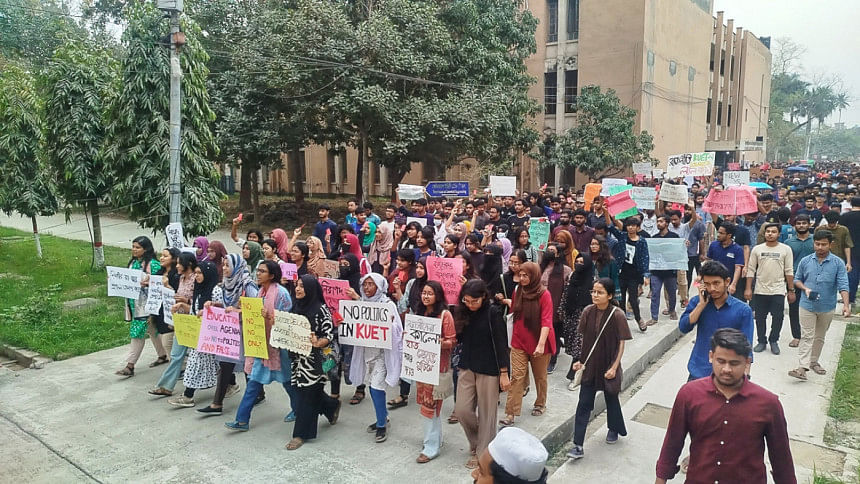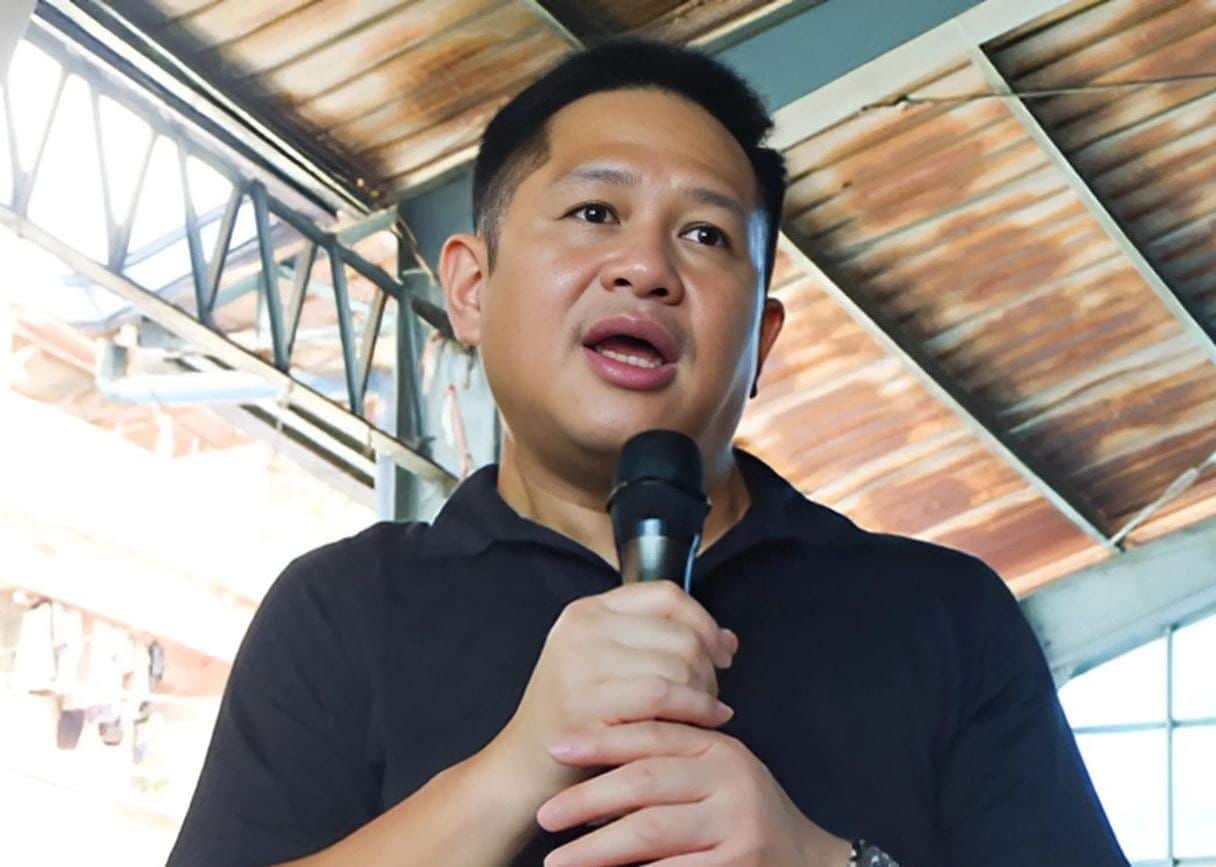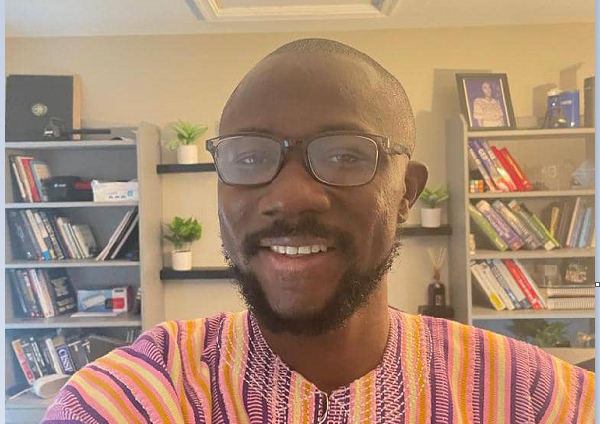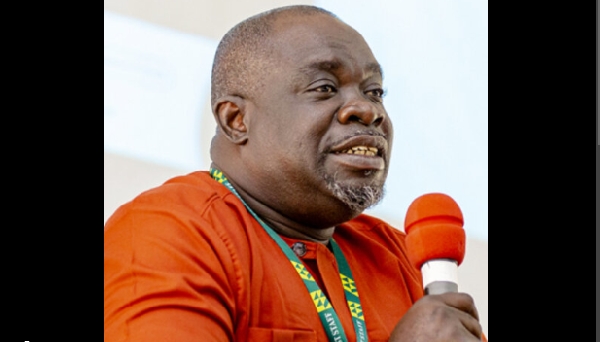A university is more than an academic institution; it is a site where young adults experience their transformative rites of passage into adulthood, their next phase of life. As educators, we want students to have a deep sense of curiosity that makes them question everything, including the power structure. We want them to be creative in their expressions while mindful of the boundaries of others.
The youthful idealism of our students' dissent is not only tolerated but nurtured within the norms of academia. Questioning authority while maintaining order is a lifelong learning tool. The sanctity of any academic institution lies in the social contract between youthful idealism and vigilant guardianship of academic integrity.

In July, our students made us proud through their fight to reclaim democratic space from the clutches of an authoritarian regime. The activism of our students ignited hope in this generation's ability to ensure justice and accountability. We were optimistic when they proclaimed to reset systems.
Seldom, however, did we realise that we were up for perpetual rebellion. Every grievance, be it personal or collective, now triggers agitation. Every administrative intervention is suspected and overruled.
Protests are not the final option—they are pitched as first responses. The system has started corroding from within. Our universities and colleges are slowly dying.
There is an emerging trend in which the administration is consistently being forced to yield to student demands. None of the institutions can stick to their disciplinary actions, whether for misconduct, academic dishonesty, or breaches of code. The aggrieved party does not resort to legal or systemic recourse.
They initiate a protest and subsequently support it with a social media campaign. Hashtags and emotional appeals amplify the outrage without a proper analysis of the context. The focus soon shifts from the ground zero of the cause to a media trial of the consequence.
I wish the situation were hypothetical. It is not. It has become the lived reality of our universities.
The situation at the Khulna University of Engineering and Technology (KUET) serves as an example. The flow of events suggests the deep-seated issues within our higher education governance, student politics, and administrative response mechanisms. It started on February 18, when two groups of students, Jatiyatabadi Chhatra Dal (JCD) and the Students Against Discrimination (SAD), clashed over demands to ban student politics.
The violence left nearly 50 students injured and marked the beginning of a prolonged crisis. The following day, students locked down all academic and administrative buildings. The KUET syndicate suspended political activities on campus and initiated a formal investigation while filing a police case against 400-500 unidentified individuals.
The decision irked the activists, as they felt that the vice-chancellor (VC) was acting at the behest of the parent organisation of JCD. They symbolically "red-carded" political organisations and demanded the VC's resignation. They also sent a memorandum to the chief adviser to draw attention to their cause.
To calm the situation, the university authority ordered the students to vacate the halls on February 25. The containment measure, however, was perceived as punitive. For nearly two months, students kept on demanding the reopening of their campus.
On April 13, students staged a sit-in demonstration. KUET syndicate met on April 14 and suspended 37 students linked to earlier clashes, with a plan to reopen halls in May. Soon after, the focus shifted to the sole demand of the VC's resignation.
Students broke into the halls and continued symbolic protests , including burning an effigy of the VC's chair. A section of the students started a hunger strike with a banner that reads, "Is the Interim Blind?" The chief adviser and a three-member, high-powered team from the University Grants Commission (UGC) and the education ministry intervened. Both the VC and the pro-VC were removed, with the administrative authority given to a senior faculty member.
Now that we clearly understand the timeline, let's examine how the initial demand to ban student politics politicised the campus environment. The issue-based activism snowballed to target institutional leadership with political ties or blessings. Where did the KUET administration go wrong? Their response was largely reactive.
They were unable to comprehend the intricacy of the circumstances surrounding the student politics ban. The SAD leaders have already formed a national-level political party. Activities of Islami Chhatra Shibir are also visible on campuses.
Yet, these two groups don't want any student politics tied to national politics to enter the campus. Banning campus politics is a policy issue, and the decision should come from the government. The politically appointed interim VCs do not have the moral high ground to deal with such a loaded issue.
The KUET authorities closed the residential halls as a quick fix. They should have sought help from the authority under which they operate. The decision to suspend students before rebuilding trust smells of authoritarianism.
It is not clear whether the suspended students were called to defend themselves in the presence of a professional counsellor. KUET is not alone in making these misjudgements. These misjudgements are a common flaw in our university governance.
We need to give credit to the students for conjuring their symbolic and performative protests. They employed symbolic red cards, burnt the effigy of the VC's chair, and launched hunger strikes to open the eyes of the interim administration to both galvanise social media support and control the narrative. Student activism today is indeed different from that of the previous generation.
I don't think our university administration is well equipped to deal with this kind of performative resistance amplified by social media and public sentiment. Consequently, procedural resolution mechanisms of the universities are threatened. What is required right now is a credible, neutral mediation framework to stop conflict from spiralling.
The KUET teachers' association have already expressed their dissatisfaction over the removal of their senior colleagues. Teachers realise that they are becoming hostages to students. Both faculty bodies and external stakeholders, such as the alumni, have failed to intervene to stem the rot.
KUET has thus exposed a systemic weakness in conflict resolution within academic institutions. One solution can be to engage institutional ombudsmen or third-party mediators to de-escalate tensions without compromising authority. The time has come for universities to sit together to create a system that fosters continuous dialogue with students and understands their needs before they morph into crises.
Before banning student politics, universities must redesign their student unions as an alternative site for student representation and leadership. The public relations offices of the universities need to reorient themselves to learn how to proactively pitch the position of the administration. We need to realise that in this image-driven post-truth world, optics can outweigh facts.
Controlling narrative needs to be part of a university's overall objective. For the greater sake of the nation, we must uphold the autonomy of the universities. Siding with the loudest voices can be popular, but may not always be beneficial.
It will kill the universities slowly—and painfully. Dr Shamsad Mortuza is professor of English at Dhaka University. Views expressed in this article are the author's own.
Follow The Daily Star Opinion on Facebook for the latest opinions, commentaries and analyses by experts and professionals. To contribute your article or letter to The Daily Star Opinion, see our guidelines for submission . A university is more than an academic institution; it is a site where young adults experience their transformative rites of passage into adulthood, their next phase of life.
As educators, we want students to have a deep sense of curiosity that makes them question everything, including the power structure. We want them to be creative in their expressions while mindful of the boundaries of others. The youthful idealism of our students' dissent is not only tolerated but nurtured within the norms of academia.
Questioning authority while maintaining order is a lifelong learning tool. The sanctity of any academic institution lies in the social contract between youthful idealism and vigilant guardianship of academic integrity. In July, our students made us proud through their fight to reclaim democratic space from the clutches of an authoritarian regime.
The activism of our students ignited hope in this generation's ability to ensure justice and accountability. We were optimistic when they proclaimed to reset systems. Seldom, however, did we realise that we were up for perpetual rebellion.
Every grievance, be it personal or collective, now triggers agitation. Every administrative intervention is suspected and overruled. Protests are not the final option—they are pitched as first responses.
The system has started corroding from within. Our universities and colleges are slowly dying. There is an emerging trend in which the administration is consistently being forced to yield to student demands.
None of the institutions can stick to their disciplinary actions, whether for misconduct, academic dishonesty, or breaches of code. The aggrieved party does not resort to legal or systemic recourse. They initiate a protest and subsequently support it with a social media campaign.
Hashtags and emotional appeals amplify the outrage without a proper analysis of the context. The focus soon shifts from the ground zero of the cause to a media trial of the consequence. I wish the situation were hypothetical.
It is not. It has become the lived reality of our universities. The situation at the Khulna University of Engineering and Technology (KUET) serves as an example.
The flow of events suggests the deep-seated issues within our higher education governance, student politics, and administrative response mechanisms. It started on February 18, when two groups of students, Jatiyatabadi Chhatra Dal (JCD) and the Students Against Discrimination (SAD), clashed over demands to ban student politics. The violence left nearly 50 students injured and marked the beginning of a prolonged crisis.
The following day, students locked down all academic and administrative buildings. The KUET syndicate suspended political activities on campus and initiated a formal investigation while filing a police case against 400-500 unidentified individuals. The decision irked the activists, as they felt that the vice-chancellor (VC) was acting at the behest of the parent organisation of JCD.
They symbolically "red-carded" political organisations and demanded the VC's resignation. They also sent a memorandum to the chief adviser to draw attention to their cause. To calm the situation, the university authority ordered the students to vacate the halls on February 25.
The containment measure, however, was perceived as punitive. For nearly two months, students kept on demanding the reopening of their campus. On April 13, students staged a sit-in demonstration.
KUET syndicate met on April 14 and suspended 37 students linked to earlier clashes, with a plan to reopen halls in May. Soon after, the focus shifted to the sole demand of the VC's resignation. Students broke into the halls and continued symbolic protests , including burning an effigy of the VC's chair.
A section of the students started a hunger strike with a banner that reads, "Is the Interim Blind?" The chief adviser and a three-member, high-powered team from the University Grants Commission (UGC) and the education ministry intervened. Both the VC and the pro-VC were removed, with the administrative authority given to a senior faculty member. Now that we clearly understand the timeline, let's examine how the initial demand to ban student politics politicised the campus environment.
The issue-based activism snowballed to target institutional leadership with political ties or blessings. Where did the KUET administration go wrong? Their response was largely reactive. They were unable to comprehend the intricacy of the circumstances surrounding the student politics ban.
The SAD leaders have already formed a national-level political party. Activities of Islami Chhatra Shibir are also visible on campuses. Yet, these two groups don't want any student politics tied to national politics to enter the campus.
Banning campus politics is a policy issue, and the decision should come from the government. The politically appointed interim VCs do not have the moral high ground to deal with such a loaded issue. The KUET authorities closed the residential halls as a quick fix.
They should have sought help from the authority under which they operate. The decision to suspend students before rebuilding trust smells of authoritarianism. It is not clear whether the suspended students were called to defend themselves in the presence of a professional counsellor.
KUET is not alone in making these misjudgements. These misjudgements are a common flaw in our university governance. We need to give credit to the students for conjuring their symbolic and performative protests.
They employed symbolic red cards, burnt the effigy of the VC's chair, and launched hunger strikes to open the eyes of the interim administration to both galvanise social media support and control the narrative. Student activism today is indeed different from that of the previous generation. I don't think our university administration is well equipped to deal with this kind of performative resistance amplified by social media and public sentiment.
Consequently, procedural resolution mechanisms of the universities are threatened. What is required right now is a credible, neutral mediation framework to stop conflict from spiralling. The KUET teachers' association have already expressed their dissatisfaction over the removal of their senior colleagues.
Teachers realise that they are becoming hostages to students. Both faculty bodies and external stakeholders, such as the alumni, have failed to intervene to stem the rot. KUET has thus exposed a systemic weakness in conflict resolution within academic institutions.
One solution can be to engage institutional ombudsmen or third-party mediators to de-escalate tensions without compromising authority. The time has come for universities to sit together to create a system that fosters continuous dialogue with students and understands their needs before they morph into crises. Before banning student politics, universities must redesign their student unions as an alternative site for student representation and leadership.
The public relations offices of the universities need to reorient themselves to learn how to proactively pitch the position of the administration. We need to realise that in this image-driven post-truth world, optics can outweigh facts. Controlling narrative needs to be part of a university's overall objective.
For the greater sake of the nation, we must uphold the autonomy of the universities. Siding with the loudest voices can be popular, but may not always be beneficial. It will kill the universities slowly—and painfully.
Dr Shamsad Mortuza is professor of English at Dhaka University. Views expressed in this article are the author's own. Follow The Daily Star Opinion on Facebook for the latest opinions, commentaries and analyses by experts and professionals.
To contribute your article or letter to The Daily Star Opinion, see our guidelines for submission ..
Politics

KUET protests and the evolving student-university relations

KUET has exposed systemic weakness in conflict resolution.














